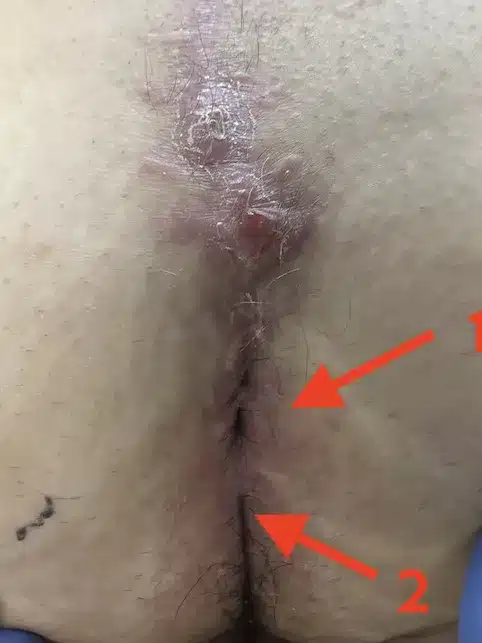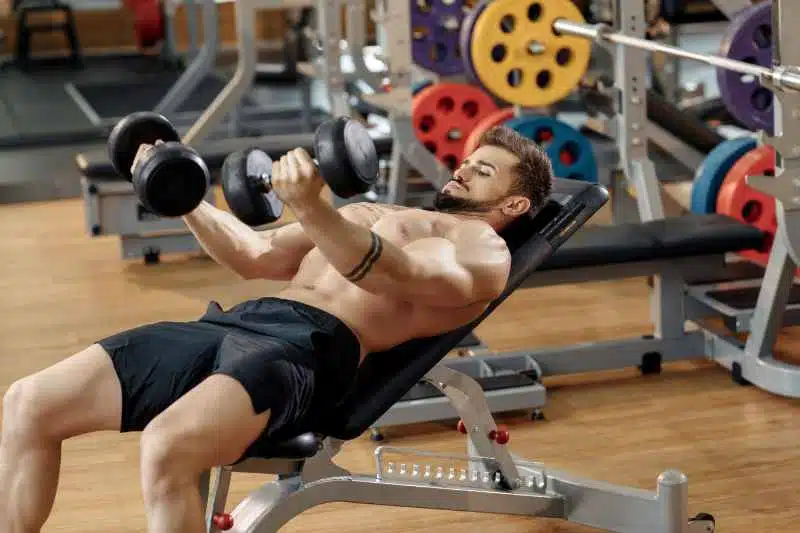Diese Seite wird im Moment grundlegend, überarbeitet, in Kürze können Sie sich hier umfassend über Ihre Situation informieren und aktiv zur Optimierung ihrer Heilungszeit beitragen. Für die gegenwärtigen Einschränkungen bitten wir um Entschuldigung.
Fehler vermeiden: Ohne perfekte Operation heilt die Wunde nicht
Die optimale Wundheilung fängt mit der Wahl der richtigen Operationsmethode und eines erfahrenen Operateurs an. Je mehr bei der Operation entfernt wird, desto größer ist die Herausforderung für Ihren Körper zu heilen – ein nicht zu unterschätzender Prozess.
Viele Patienten versuchen es zunächst mit einer Operation im nächstgelegenen Krankenhaus und denken, sie würden nur bei Problemen zu einem Spezialisten wechseln. Dieser Ansatz kann zu einer unerwartet langen Heilungszeit führen und Ausfallzeiten in Schule, Beruf und beim Sport nach sich ziehen. Unsere fortschrittlichen Therapien sind darauf ausgerichtet, solche Probleme zu vermeiden. Informieren Sie sich vor Ihrer Entscheidung über Erfahrungen und Bewertungen anderer Patienten. Eine weite Anfahrt zu einer spezialisierten Einrichtung zahlt sich meistens aus.
Bereits operiert? Ihre Checkliste für die Nachbehandlung
Wurden Sie an einer Steißbeinfistel operiert und sind unsicher, wie Sie nun richtig mit der Wunde umgehen? Es ist verständlich, dass Sie angesichts der zahlreichen Meinungen von Ärzten, Bekannten und im Internet verunsichert sind. Mit unserer Checkliste Wundheilung fassen wir zusammen, was wirklich wichtig ist. Der Erfolg oder Mißerfolg einer Operation bei Steißbeinfistel entscheidet sich in den ersten 4 – 6 Wochen nach dem Eingriff.
Bestandsaufnahme: War die durchgeführte Operation geeignet, die Fistel zu heilen?
War Ihre Behandlung auf das Entfernen einer Steißbeinfistel ausgerichtet oder wurde lediglich ein Abszess gespalten? Selbst wenn Sie sich momentan beschwerdefrei fühlen, ist in der Regel ein zweiter Eingriff erforderlich. Ohne diesen Eingriff bleibt das Risiko für das erneute Auftreten von Abszessen hoch.
Das war nur der erste von zwei Schritten: Beispiele für Abszess-Drainage

Lorem ipsum dolor sit amet, consectetur adipiscing elit. Ut elit tellus, luctus nec ullamcorper mattis, pulvinar dapibus leo.

Lorem ipsum dolor sit amet, consectetur adipiscing elit. Ut elit tellus, luctus nec ullamcorper mattis, pulvinar dapibus leo.

Lorem ipsum dolor sit amet, consectetur adipiscing elit. Ut elit tellus, luctus nec ullamcorper mattis, pulvinar dapibus leo.
So soll es nicht aussehen: Beispiele für unvollständige Fistelentfernung
Haben Sie eine vollständige Entfernung der Steißbeinfistel durchführen lassen? Es ist wichtig, die gesamte Gesäßfalte sorgfältig zu inspizieren, um sicherzustellen, dass keine auffälligen Öffnungen zurückgeblieben sind. Das Vorhandensein solcher Öffnungen kann ein klares Anzeichen für ein drohendes Rezidiv sein. Ergreifen Sie bei Verdacht sofort die Initiative und konsultieren Sie einen in dieser Angelegenheit spezialisierten Arzt.

Leider keine Seltenheit: Trotz wiederholter Operationen unter Narkose bleibt der Ursprung der Fistel unbemerkt. So kann keine Heilung erfolgen.

Lorem ipsum dolor sit amet, consectetur adipiscing elit. Ut elit tellus, luctus nec ullamcorper mattis, pulvinar dapibus leo.

Lorem ipsum dolor sit amet, consectetur adipiscing elit. Ut elit tellus, luctus nec ullamcorper mattis, pulvinar dapibus leo.
Grundlagen der Wundheilung
Nach einer Steißbeinfistel-OP muss man je nach Verfahren unterschiedliche Schwerpunkte setzen, was die Nachbehandlung angeht. Es ist hilfreich, zu wissen, welche physiologischen Vorgänge im Körper ablaufen, wenn eine Wunde heilt.
Primäre Wundheilung bei geschlossenen Verfahren (Mittellinien-Naht, Karydakis Operation)
Bei der primären Wundheilung nach chirurgischen Eingriffen mit Wundverschluss wird die Wunde genäht, geklammert oder geklebt. Anschließend durchläuft die Heilung vier Phasen:
- Koagulationsphase (Tag 1): Hier verkleben Blutplättchen und Gerinnungsfaktoren die Wunde. Das dabei entstehende Fibrin ist der körpereigene Superkleber. Antikörper und weiße Blutkörperchen sind aktiv für die Infektionsabwehr. Der Zusammenhalt wird vor allem durch die Hautfäden gewährleistet, daher sollten Belastungen vermieden werden.
- Inflammationsphase (Tag 1 – 4): Es werden Botenstoffe ausgeschüttet, die eine Gefäßerweiterung, verstärkte Durchblutung, Gefäßneubildung und das Anlocken von Bindegewebszellen (Fibroblasten) bewirken. Diese Fibroblasten sind wahre Meister in der Produktion von stabilisierenden Fasern. Die verstärkte Durchblutung ist an der rötlichen oder violetten Farbe der Narbe erkennbar. Die mechanische Stabilität ist noch gering.
- Proliferationsphase (Tag 5-14): Die Fibroblasten vermehren sich und bilden Prokollagen. Dieses Protein wandelt sich in Tropocollagen um und enthält größere Anteile der Aminosäuren Lysin, Glycin und Prolin. Die durch Quervernetzung dieser Proteine entstehenden Kollagenfibrillen geben der Narbe mechanische Festigkeit.
- Kontraktionsphase (Tag 15 -): In dieser Phase befinden sich Aufbau und Abbau der Kollagenfibrillen im Gleichgewicht, und die Fasern ordnen sich neu an. Die mechanische Festigkeit der Narbe nimmt weiter zu, während sich die Farbe allmählich dem normalen Hautton angleicht. Die Narbe zieht sich zusammen und nimmt eine kompaktere Struktur an. Die Narbe ist nun wieder voll belastbar.
Sekundäre Wundheilung bei offenen Verfahren ("Metzger"-Methode, Pit Picking, Sinusektomie)
Bei einer Steißbeinfistel-OP wählt man meist die offene Wundbehandlung mit sekundärer Wundheilung. Auch hier durchläuft der Heilungsprozess die genannten Abschnitte. Zwischen Phase 2 und 3 muss sich zuerst die Wunde auffüllen, bevor sie sich in Phase 3 und 4 festigen kann. Dies geschieht in der Granulationsphase (Proliferative Phase): Neue Blutgefäße (Angiogenese) bilden sich, um das Gewebe mit Nährstoffen und Sauerstoff zu versorgen. Fibroblasten wandern in die Wunde ein und produzieren Kollagen, das als Gerüst für das neue Gewebe dient. Es bildet sich Granulationsgewebe, das aus neu gebildeten Blutgefäßen, Kollagen und anderen Bindegewebsbestandteilen besteht. Die Wunde füllt sich von unten nach oben mit diesem Gewebe. Die mechanische Belastbarkeit ist zu jedem Zeitpunkt gegeben.
Nachbehandlung im Einzelnen
Effektive Nachsorge und Pflege der Wunde
- Entfernen Sie die Haare rund um die Wunde in einem etwa 2 cm breiten Saum durch Rasieren, Enthaarungscreme, Wachs oder Zupfen. Besonders wichtig ist die Zone 3 cm unterhalb des tiefsten Wundpunktes, ein Bereich, den Sie einsehen können, indem Sie die Pobacken leicht auseinanderziehen.
- Zudem ist 1 – 2 x tägliches Duschen unerlässlich, um Wundsekret zu beseitigen und die bakterielle Belastung zu minimieren. Eine saubere Hautoberfläche beherbergt 10.000-mal weniger Bakterien und fördert eine schnellere und sicherere Heilung. Richten Sie Ihre ganze Aufmerksamkeit auf diese beiden Punkte, um den Heilungsprozess optimal zu unterstützen!
- Wundspülungen mit sterilen Lösungen (physiologische NaCL-Lösung, Antiseptika) entsprechen der offiziellen Empfehlung des RKI, sind aus unserer Sicht aber nicht zwingend notwendig. Der Eingriff der Sinusektomie hinterläßt keine leidlich drainierte Abszess-Höhle, sondern eine weitgehend „saubere“ Wundhöhle durch sorgfältiges Entfernen der Fistelkapsel.
- Anleitung zur richtigen Wundreinigung und -pflege
- Verwendung von speziellen Wundauflagen und -verbänden
- Hinweise zur Vermeidung von Infektionen
- Haarentfernung
Wenn die Haare entfernt werden, wird die Fistel heilen.
1965 Peter H. Lord und Douglas M. Millar, Pit Picking Erfinder
Ernährung und Lebensstil
– Ernährungstipps zur Unterstützung der Wundheilung (z.B. proteinreiche Kost, Vitamine)
– Bedeutung von ausreichender Flüssigkeitszufuhr
– Raucherentwöhnung und deren Einfluss auf die Heilung
Schmerzkontrolle
– Schmerzmanagement und geeignete Schmerzmittel
– Alternative Methoden zur Schmerzlinderung (z.B. Kühlung, Entspannungstechniken)
Aktivitätsanpassungen
– Empfehlungen zur körperlichen Schonung und Bewegungseinschränkungen
– Tipps für den Wiedereinstieg in den Alltag und sportliche Aktivitäten
Hygiene und Kleidung
– Geeignete Kleidung und Unterwäsche zur Minimierung von Reibung und Druck
– Hygienemaßnahmen im Alltag, um die Wunde sauber zu halten
Warnzeichen und Komplikationen
– Erkennung von Anzeichen einer Wundinfektion oder anderen Komplikationen
– Wann ein Arzt aufgesucht werden sollte
Narbenpflege und kosmetische Aspekte
– Methoden zur Reduktion von Narbenbildung
– Verwendung von Narbensalben und -cremes
Psychologische Unterstützung
– Umgang mit emotionalen und psychischen Belastungen nach der Operation
– Unterstützung durch Selbsthilfegruppen oder psychologische Beratung
Langzeitprognose und Rückfallprävention
– Langfristige Prognose und Möglichkeiten zur Prävention eines Rückfalls
– Tipps zur Vermeidung erneuter Fisteln (z.B. Haarentfernung in der betroffenen Region)
Erfahrungsberichte und Patientenforen
– Austausch von Erfahrungen und Tipps mit anderen Betroffenen
– Zugang zu Online-Foren und Selbsthilfegruppen
Diese Maßnahmen können Sie getrost weglassen
- Antibiotika können kurzfristig hilfreich sein, insbesondere nach einem vollständigen Nahtverschluss der Wunde. Die erste Dosis wird typischerweise bei der Narkoseeinleitung verabreicht, entweder als Infusion oder als Tablette am Morgen der Operation. Die Fortführung dieser Behandlung über einen längeren Zeitraum ist jedoch unter Experten umstritten. Eine präventive Antibiotikagabe zur Vermeidung von Wundinfektionen sollte in der Regel nicht länger als drei Tage dauern.
- Tamponaden erweisen sich oft als schmerzhaft und ineffektiv. Nach der Entfernung einer Fistel ist die Wunde in der Regel relativ sauber und sollte nicht künstlich offen gehalten werden. Dies unterscheidet sich von der Behandlung eines Abszesses, bei dem es notwendig sein kann, den Abfluss von Eiter für einige Tage zu sichern.
- Die Entfernung von Hypergranulationen, auch als „wildes Fleisch“ bekannt, mit Verätzung (Silbernitrat) oder mechanisch, ist kontraproduktiv. Diese Wucherungen sind ein Indiz für Heilungshindernisse, verursacht durch eingewachsene oder lose Haare und damit Begleiterscheinung und nicht Ursache des Problems.
Die Wunde heilt nicht oder ist wieder aufgegangen?
Überlassen Sie Ihre Wundheilung nicht dem Zufall – handeln Sie jetzt!
Plan B bei stagnierender Wundheilung: Trotz eines unauffälligen Ultraschallbefunds und optimaler Pflege kommt es vor, dass eine Wunde nicht heilt. Wenn über einen Zeitraum von ein bis zwei Monaten kein Heilungsfortschritt erkennbar ist, muss man sich der Realität stellen: Ein weiterer Eingriff könnte notwendig werden. In Betracht gezogen werden dabei eine erneute Wundsäuberung oder die Durchführung einer Karydakis-Plastik.
Zögern Sie die Entscheidung für einen erneuten plastisch-rekonstruktiven Eingriff nicht unnötig hinaus. Verzögerungen führen nur zu Zeitverlust und enttäuschten Hoffnungen. Zudem sollten Sie keine übermäßige Angst vor dem Eingriff haben. Wenn dieser von einem erfahrenen Operateur durchgeführt wird, kann er eine effektive und dauerhafte Lösung für Ihr Wundheilungsproblem darstellen.
Sport nach Steissbeinfistel-OP
Sport ist ein echter Booster für die Gesundheit – sogar für Patienten nach einer Operation! Das Fast-Track-Konzept der chirurgischen Rehabilitation baut genau darauf auf.
Wir haben gelernt, dass Bettruhe, Gipsverbände und Nahrungskarenz nicht förderlich sind, sondern eher schaden können (Stichwort: Inaktivitätsatrophie und katabole Stoffwechselzustände).

Offene Wundbehandlung: Sport uneingeschränkt erlaubt Geschlossene Wundbehandlung: Sport nach 2 Wochen
Welche Sportarten sind problematisch? Welche sind empfehlenswert?
Literatur: Steissbeinfistel und Sport
DR. BERNHARD HOFER & FLORIAN LIEBL
Fachärzte für Viszeralchirurgie und Proktologie – PartG mbB
Brienner Str. 13, D-80333 München
- info@darmsprechstunde.de
- Montag - Freitag: 08.00 - 13.00 und 14.00 - 18.00
- und nach Vereinbarung
- Samstag, Sonntag, Feiertag : geschlossen
- Beachten Sie auch unsere Hinweise im Titel dieser Website und auf unserer Telefonansage.
© 2023 Proktologische Praxis München
